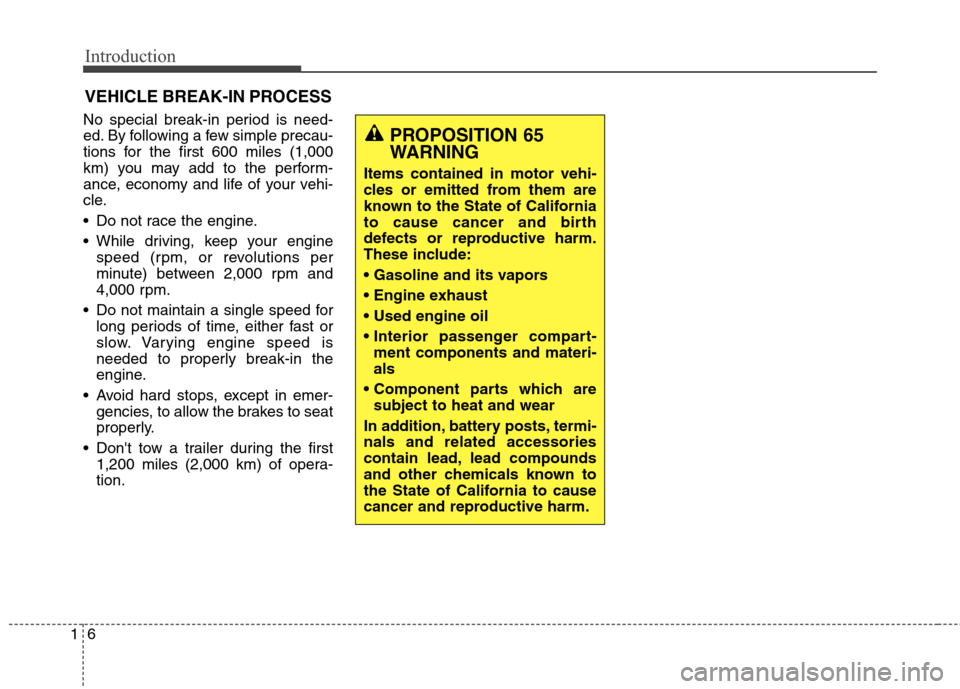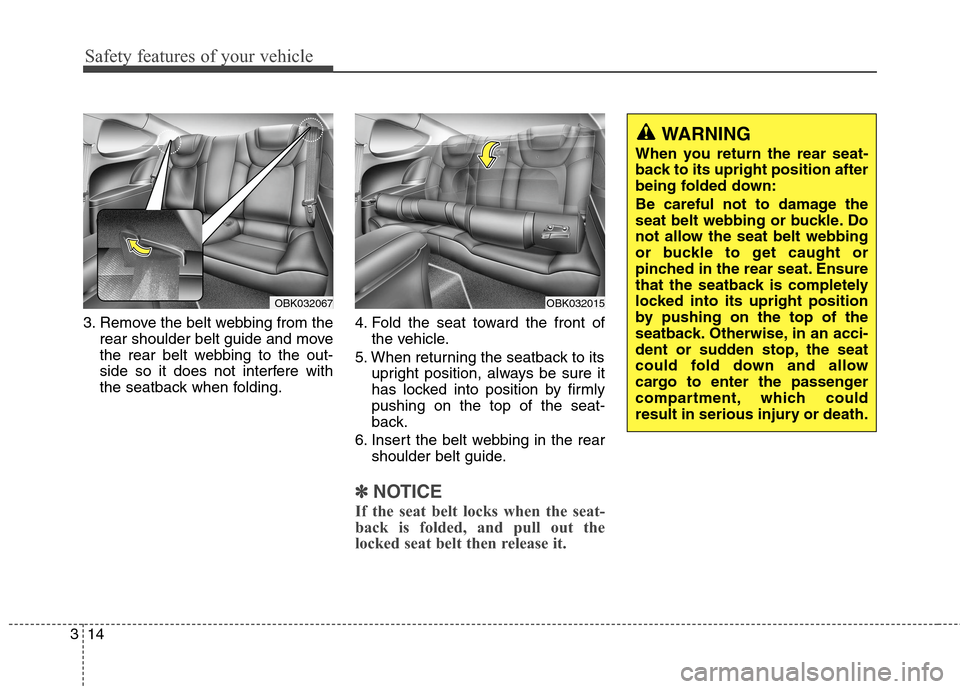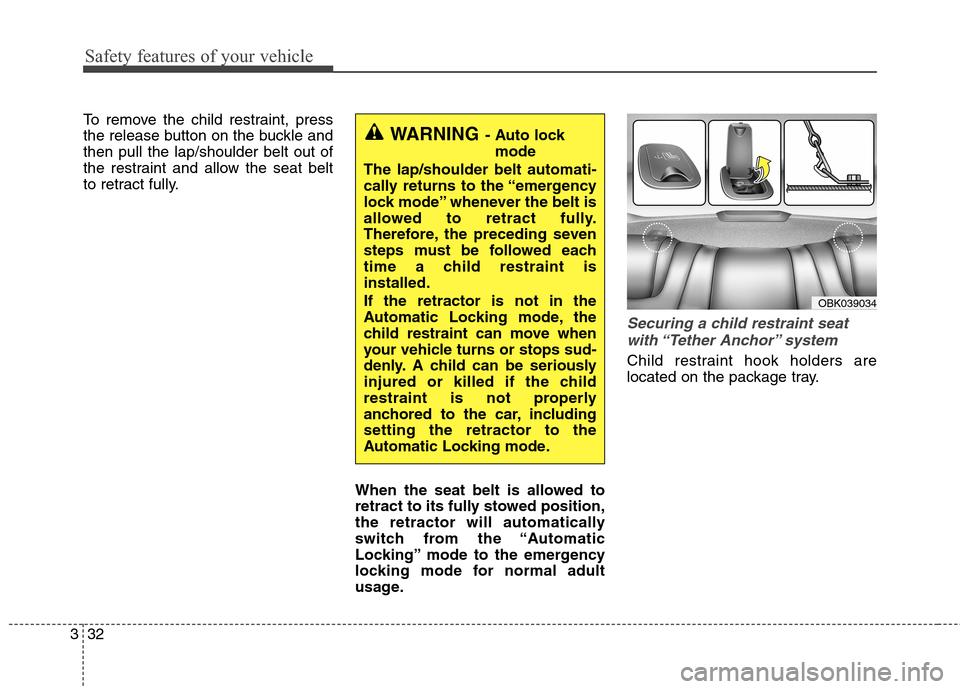Page 7 of 438

1
2
3
4
5
6
7
8
I
IntroductionHow to use this manual / Fuel requirements / Vehicle break-in process /
Vehicle data collection and event data recorders / Indicator symbols on the instrument cluster
Your vehicle at a glance
Exterior overview / Interior overview / Instrument panel overview / Engine compartment
Safety features of your vehicle
Seats / Seat belts / Child restraint system / Air bag
Features of your vehicleKeys / Door locks / Trunk / Windows / Hood / Fuel filler lid / Sunroof / Steering wheel / Mirrors /
Instrument cluster / Multigauge / Lighting / Wipers & Washers / Climate control system / Etc.
Driving your vehicleBefore driving / Engine start/stop button / Transmission / Brake system / Cruise control system /
Winter driving / Vehicle load limit / Etc.
What to do in an emergencyRoad warning / Emergency while driving / Emergency starting / Engine overheat / TPMS / Flat tire / Towing / Etc.
MaintenanceEngine compartment / Maintenance service / Engine oil / Engine coolant / Brake fluid / Washer fluid /
Parking brake / Air cleaner / Wiper blades / Battery / Tire and wheels / Fuses / Light bulbs / Etc.
Specifications, Consumer information and Reporting safety defects
Index
table of contents
Page 13 of 438

Introduction
6 1
No special break-in period is need-
ed. By following a few simple precau-
tions for the first 600 miles (1,000
km) you may add to the perform-
ance, economy and life of your vehi-
cle.
Do not race the engine.
While driving, keep your engine
speed (rpm, or revolutions per
minute) between 2,000 rpm and
4,000 rpm.
Do not maintain a single speed for
long periods of time, either fast or
slow. Varying engine speed is
needed to properly break-in the
engine.
Avoid hard stops, except in emer-
gencies, to allow the brakes to seat
properly.
Don't tow a trailer during the first
1,200 miles (2,000 km) of opera-
tion.
PROPOSITION 65
WARNING
Items contained in motor vehi-
cles or emitted from them are
known to the State of California
to cause cancer and birth
defects or reproductive harm.
These include:
ment components and materi-
als
subject to heat and wear
In addition, battery posts, termi-
nals and related accessories
contain lead, lead compounds
and other chemicals known to
the State of California to cause
cancer and reproductive harm.
VEHICLE BREAK-IN PROCESS
Page 17 of 438
Your vehicle at a glance
2 2
EXTERIOR OVERVIEW (FRONT)
1. Removable towing hook .......................6-21
2. Windshield wiper ..................................4-87
3. Outside rearview mirror .......................4-43
4. Door lock ..............................................4-16
5. Head lights ...........................................4-82
6. Front fog lamp ......................................4-86
7. Hood ...................................................4-26
8. Tire & wheel ..................................7-23, 8-3
9. Parking assist system ..........................4-76
OBK012005L
Page 18 of 438
23
Your vehicle at a glance
EXTERIOR OVERVIEW (REAR)
1. Glass antenna ....................................4-128
2. Rear window defroster .........................4-91
3. Fuel filler lid ..........................................4-27
4. Rear combination lights .......................7-71
5. Rear parking assist system..................4-73
6. Removable towing hook .......................6-21
7. Trunk ....................................................4-20
8. Windows ...............................................4-22
OBK012006
Page 29 of 438
Safety features of your vehicle
8 3
Forward and rearward adjustment
The headrest may be adjusted for-
ward to 3 different positions by
pulling the headrest forward to the
desired detent. To adjust the head-
rest to it’s furthest rearward position,
pull it fully forward to the farthest
position and release it. Adjust the
headrest so that it properly supports
the head and neck.Adjusting the height up and down
To raise the headrest, pull it up to the
desired position (1). To lower the
headrest, push and hold the release
button (2) on the headrest support
and lower the headrest to the desired
position (3).
OBK039005OBK039006
CAUTION
If you recline the seatback
towards the front with the head-
rest and seat cushion raised,
the headrest may come in con-
tact with the sunvisor or other
parts of the vehicle.
OYFH034205
Page 35 of 438

Safety features of your vehicle
14 3
3. Remove the belt webbing from the
rear shoulder belt guide and move
the rear belt webbing to the out-
side so it does not interfere with
the seatback when folding.4. Fold the seat toward the front of
the vehicle.
5. When returning the seatback to its
upright position, always be sure it
has locked into position by firmly
pushing on the top of the seat-
back.
6. Insert the belt webbing in the rear
shoulder belt guide.
✽ ✽
NOTICE
If the seat belt locks when the seat-
back is folded, and pull out the
locked seat belt then release it.
OBK032015OBK032067
WARNING
When you return the rear seat-
back to its upright position after
being folded down:
Be careful not to damage the
seat belt webbing or buckle. Do
not allow the seat belt webbing
or buckle to get caught or
pinched in the rear seat. Ensure
that the seatback is completely
locked into its upright position
by pushing on the top of the
seatback. Otherwise, in an acci-
dent or sudden stop, the seat
could fold down and allow
cargo to enter the passenger
compartment, which could
result in serious injury or death.
Page 53 of 438

Safety features of your vehicle
32 3
To remove the child restraint, press
the release button on the buckle and
then pull the lap/shoulder belt out of
the restraint and allow the seat belt
to retract fully.
When the seat belt is allowed to
retract to its fully stowed position,
the retractor will automatically
switch from the “Automatic
Locking” mode to the emergency
locking mode for normal adult
usage.
Securing a child restraint seat
with “Tether Anchor” system
Child restraint hook holders are
located on the package tray.
OBK039034
WARNING- Auto lock
mode
The lap/shoulder belt automati-
cally returns to the “emergency
lock mode” whenever the belt is
allowed to retract fully.
Therefore, the preceding seven
steps must be followed each
time a child restraint is
installed.
If the retractor is not in the
Automatic Locking mode, the
child restraint can move when
your vehicle turns or stops sud-
denly. A child can be seriously
injured or killed if the child
restraint is not properly
anchored to the car, including
setting the retractor to the
Automatic Locking mode.
Page 65 of 438

Safety features of your vehicle
44 3
Always be sure that you and all vehi-
cle occupants are seated and
restrained properly (sitting upright with
the seat in an upright position, cen-
tered on the seat cushion, with the
person's legs comfortably extended,
feet on the floor, and wearing the safe-
ty belt properly) for the most effective
protection by the air bag and the safe-
ty belt.
The OCS may not function proper-
ly if the passenger takes actions
which can affect the detection sys-
tem. These include:
(1) Failing to sit in an upright posi-
tion.
(2) Leaning against the door or
center console.
(3) Sitting towards the sides or the
front of the seat.
(4) Putting legs on the dashboard
or resting them on other loca-
tions which reduce the passen-
ger weight on the front seat.
(5) Improperly wearing the safety
belt.
(6) Reclining the seat back.Condition and operation of the front passenger occupant classification
system
*1) The system judges a person of
adult size as an adult. When a
smaller adult sits in the front pas-
senger seat, the system may rec-
ognize him/her as a child depend-
ing on his/her physique and pos-
ture.
*2) Do not allow children to ride in the
front passenger seat. When a
smaller child than the same age
sits in the front passenger seat,
the system may recognize
him/her as an infant depending on
his/her physique or posture.*3) Never install a child restraint sys-
tem on the front passenger seat.
WARNING
Riding in an improper position
or placing weight on the front
passenger's seat when it is
unoccupied by a passenger
adversely affects the occupant
classification system (OCS).
(Continued)
Condition detected by
the occupant classifica-
tion system
1. Adult *
1
2. Child *2*3 of about 36
months old and
younger with child
restraint system
3. Unoccupied
4. There is a malfunc-
tion in the system
Off
On
On
OffOff
Off
Off
OnActivated
Deactivated
Deactivated
Activated
PASSENGER AIR BAG
"OFF" indicator lightSRS warning lightFront passenger air
bag
Indicator/Warning light Devices